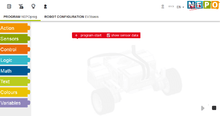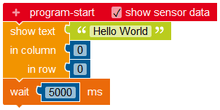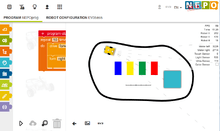Open Roberta
Open Roberta is the name of a project within the German education initiative "Roberta—Learning with robots", initiated by Fraunhofer IAIS, which is an institute belonging to the Fraunhofer Society. With Open Roberta Fraunhofer IAIS is looking to encourage children to code by using robots such as Lego Mindstorms, and other programmable hardware systems such as Arduino, BBC micro:bit, and the Calliope mini. The Cloud-approach of the Open Roberta Lab is intended to simplify programming concepts and make it easier for teachers and schools to teach how to code.[1] Open Roberta is free and does not require any installation. The project was initially founded with €1Mio by Google.org.[2][3]
| Paradigm | event-driven, imperative |
|---|---|
| Designed by | Beate Jost, Reihard Budde, Thorsten Leimbach, Achim Kapusta |
| Developer | Fraunhofer IAIS, Media Engineering Department |
| First appeared | 2013 (test) 2014 (official) |
| Stable release | 2.0
/ October 11, 2016 |
| Typing discipline | dynamic |
| Implementation language | Java, JavaScript, html (NEPO) |
| OS | Windows, Linux, iOS |
| License | Apache License 2 |
| Website | www |
| Influenced by | |
| Scratch, Blockly | |
Open Roberta Lab

Open Roberta Lab is cloud-based programming environment and is the user-facing middleware in a chain of software and firmware bits that make a robot work in a classroom environment.[4] This environment allows children and young people with no technical pre-knowledge to program a LEGO MINDSTORMS [5] EV3 and NXT robot, as well as the Arduino based robot Bot'n Roll ONE A,[6] the BBC micro:bit,[7] and the Calliope mini.[8] As of the release 2.3.0, the microboard B-O-B-3 and as of release 3.0 the microboards Arduino Uno, Arduino Nano and Arduino Mega can also be programmed using Open Roberta. There is a variety of different program blocks available to program the motors, sensors, and the EV3 brick.[9] Open Roberta Lab uses the approach of visual programming. This approach makes it easier, especially for beginners with no experience, to learn how to code. As a cloud based programming environment no installation is needed and any operating system (Mac OS, Windows, Linux) and computer hardware device may be used.[10][11] One of the advantages of Open Roberta Lab is that it can be used with any device (PC, tablet, smartphone); only a web browser is needed. The Lab can be used without registration, and no user account is needed. As of the release 2.2.1, the Linux-based operating system EV3dev is officially supported for the LEGO MINDSTORMS EV3 robot. Open Roberta Lab is available in the following languages: Catalan, Czech, Danish, Dutch, English, Finnish, French, German, Italian, Polish, Portuguese, Russian, Spanish and Turkish.
Open source community
The programming platform Open Roberta Lab is open source developed.[12] Both the software as well as the open source development tools are available on a server of Fraunhofer Society. The development team at Fraunhofer works together with teachers and education experts from the Roberta network. Therefore, also universities and students are involved in the development. It should address especially female students - the guiding principle of the Roberta project.
Programming language NEPO®

NEPO is a free open source meta programming language that can be used by students, scholars, teachers, and other interested persons within the Open Roberta Lab. NEPO translates to New Easy Programming Online (or simply OPEN read backwards). NEPO is the name of the graphical programming language and its coupled hardware connection layer. NEPO uses the freely available Blockly library. In addition within NEPO there are additional functionalities and improvements which have been adapted for Open Roberta. The programming paradigm of NEPO is inspired by Scratch, which was developed by the Massachusetts Institute of Technology. A NEPO block always represents and encapsulates a certain robot functionality. A blocks feature set can easily be recognized through the associated block category, for example »sensors«. Programming with NEPO follows a simple principle. The blocks are interconnected and will be executed by the robot according to their order. This principle is called "sequential operation."
NEPO block categories
All available blocks are listed and categorized as the Action, Sensors, Control, Logic, Math, Text, Colours, Variables, Functions, and Massages as shown in the table below.
| Category | Notes | Category | Notes | |||
|---|---|---|---|---|---|---|
| Action | Includes blocks for the robot to be performed directly. | Text | Includes blocks to write strings on the robot display. | |||
| Sensors | Contains blocks for all standard sensors of the EV3 system. | Colours | Standard colour blocks to compare sensor inputs. | |||
| Control | Includes blocks for the program sequence control. The category includes the following blocks: If .. do, If .. do .. else, repeat indefinitely, repeat .. times, wait .. ms, wait until .. | Variables | Local and global variables can be defined. | |||
| Logic | With the »logic« blocks, conditions can be created. With this condition you can interrelate states, values, and events with each other. | Functions | Functions with input and output parameters can be defined. | |||
| Math | Mathematical operators and parameter blocks. | Messages | Includes blocks to send and receive bluetooth massages. | |||
| List | Includes blocks to create a list and to search or sort list elements. | program-start | Each program starts with this block. This block is always available in the workspace. | |||
NEPO input / output connector

Depending on the block different values can be passed to a block. The type of the value can be identified by the colored compounds (called including »connectors«) of a block. In the chapter »block category« you can see the different values a block may have. Only if the colors of the input and the output connector match, these blocks can be connected.
A block may optionally also pass a value to another block. These blocks have colored output connectors. Only if the colors of the input and the output connector are the same, these blocks can be connected.

In total there are six input and output types within NEPO. These types can have the following values:
- Logical value (light blue)
- Number (dark Blue)
- String / Text (green)
- Colour (yellow)
- List (purple)
- Connection (pink)
Open Roberta Simulator

Since version beta 1.3.0 the Open Roberta Lab also offers a simulation environment. This is a simulation of a two-dimensional robot model equipped with two wheels (differential drive). To program the simulated robot also the programming language NEPO may be used. The simulated 2D model includes the simulation of an ultrasonic sensor, a touch sensor, a color sensor and the display of an LED. In addition, different environments can be chosen. Since version beta 1.4.0 NEPO blocks can used without any changes for the 2D-Simulation and the real robot.
Open Roberta Gallery
As of release 2.3.0, the "Gallery" is available, allowing users to share their own programs with everyone else. Logged-in users with a verified account can share their programs by clicking "edit" in the menu bar, followed by a click on the menu point "my programs." In the following overview of the programs saved online, they then just have to click on the gallery-icon on the right-hand side.
In order to load a program off the Gallery, users – logged in or not – double-click on the chosen program and are then able to view, change or download its content.
Integrated Systems
| System | Programming Language | Firmware |
|---|---|---|
| LEGO Mindstorms EV3 | JAVA, Python, C/C++ | leJOS, EV3dev, c4ev3 |
| LEGO Mindstoms NXT | Not eXactly C (NXC) | original LEGO |
| Calliope mini | C++ | Micro:Bit runtime |
| micro:bit | MicroPython | Micro:Bit runtime |
| NAO | Python | original NAO |
| Bot'n Roll | C++ | Arduino + Bot'n Roll libriaries |
| Edison | MicroPython | original Edison |
| WeDo2 | JASON Stackmaschine | original Lego |
| Arduino Uno/Nano/Mega | C/C++ | original Arduino |
History
Open Roberta is a technological extension of the "Roberta concept". Roberta (short for: "Roberta - Learning with robots") is a Fraunhofer education initiative founded in 2002 by the Germany Ministry of Education and Research. Since 2002 over 350,000 students have participated in Roberta courses.
Awards
Open Roberta was awarded the "Bundessieger 2015" at the challenge "Germany Land of Ideas" in the education category.[13] In 2016, Open Roberta won the bitkom award "d-elina" in the professional category.[14]
References
- "Open Roberta – a Web Based Approach to Visually Program Real Educational Robots". Tidsskrift. Retrieved 29 December 2019.
- Berkler, Katrin. "Pressemitteilung vom 24.03.2015". Fraunhofer. Retrieved 29 December 2019.
- "„Open Roberta" – Fraunhofer, Google und LEGO Education lassen die Roboter los". Google Product Blog. Retrieved 29 December 2019.
- Williams, Elliot. "Open Robots with Open Roberta". Hackaday. Retrieved 29 December 2019.
- Willner-Giwerc, Sara. "Open Roberta: a review". Lego Engineering. Retrieved 29 December 2019.
- "Bot'n Roll ONE a Robot".
- "The Micro:bit Foundation is a global non-profit organisation making invention with technology fun for everyone!". microbit.org. Retrieved 2016-11-16.
- "CALLIOPE | Home". calliope.cc. Retrieved 2016-11-16.
- Geek in Sydney
- „Open Roberta Lab“ Archived 2015-06-25 at the Wayback Machine
- Jost, B., Ketterl, M., Budde, R., Leimbach, T. Graphical Programming Environments for Educational Robots: Open Roberta – Yet another One?, in IEEE International Symposium on Multimedia (ISM), December 2014
- Sawers, Paul. "With Open Roberta, Google wants to help German school kids learn to program with robots". The Next Web. Retrieved 29 December 2019.
- Germany Land of Ideas Archived 2015-12-08 at the Wayback Machine
- Streim, Andreas. "Bitkom zeichnet beste E-Learning-Projekte aus". bitkom. Retrieved 29 December 2019.